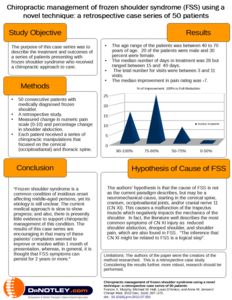 Chiropractic Management of Frozen Shoulder Syndrome
Chiropractic Management of Frozen Shoulder Syndrome
doi: 10.1016/j.jcm.2012.07.001
The purpose of this case series was to describe the treatment and outcomes of a series of patients presenting with frozen shoulder syndrome who received a chiropractic approach to care.
Methods
The authors looked back (retrospective study) at 50 consecutive patients, in their office, who were medically diagnosed with frozen shoulder.
They measured change in the patients’ numeric pain scale (0-10) and percentage change in shoulder abduction (bring the arm out to the side and up over head). Each patient received a series of chiropractic manipulations/adjustments that focused on the cervical (occipitoatlantal) and thoracic spine. There was no indication if any exercises or mobility exercises were given. I will have to assume nothing else was done during the office visit
Results
- The age range of the patients was between 40 to 70 years of age. 20 of the patients were male and 30 percent were female.
- The median number of days in treatment was 28 but ranged between 15 and 40 days.
- The total number for visits were between 3 and 11 visits
- The median improvement in pain rating was -7. In improvement of 7 points in the numeric pain scale
Conclusion
“Frozen shoulder syndrome is a common condition of insidious onset affecting middle-aged persons, yet its
etiology is still unclear. The current medical approach is slow to show progress; and also, there is presently
little evidence to support chiropractic management of this condition. The results of this case series are encouraging in that many of these patients’ complaints seemed to improve or resolve within 1 month of presentation, whereas, in general, it is thought that frozen shoulder syndrome symptoms can persist for 2 years or more.”
Hypothesis of the cause of Frozen Shoulder Syndrome
The authors’ hypothesis is that the cause of frozen shoulder sydrome is not as the current paradigm describes, but may be a neuromechanical cause, starting in the cervical spine, cranium, occipitoatlantal joints, and/or cranial nerve 11 (CN XI). This causes a malfunction of the trapezius muscle which negatively impacts the mechanics of the shoulder. In fact, the literature well describes the most common symptoms of CN XI injury as reduced shoulder abduction, drooped shoulder, and shoulder pain, which are also found in FSS. “The inference that CN XI might be related to FSS is a logical step”.
My Thoughts
This is an interesting study. It indicates that manipulation of the neck and upper back may result in a speedier recovery of frozen shoulder compared to the natural history of the syndrome. This is promising and may be an option for someone struggling with frozen shoulder.
There may be some bias in this study because the authors of the paper are the creators of the technique that they used on their patients. More research needs to be performed. The study needs to be repeated as a random controlled trial to see if there is an actual benefit in this form of care.
Originally posted on May 17, 2022 @ 4:38 pm